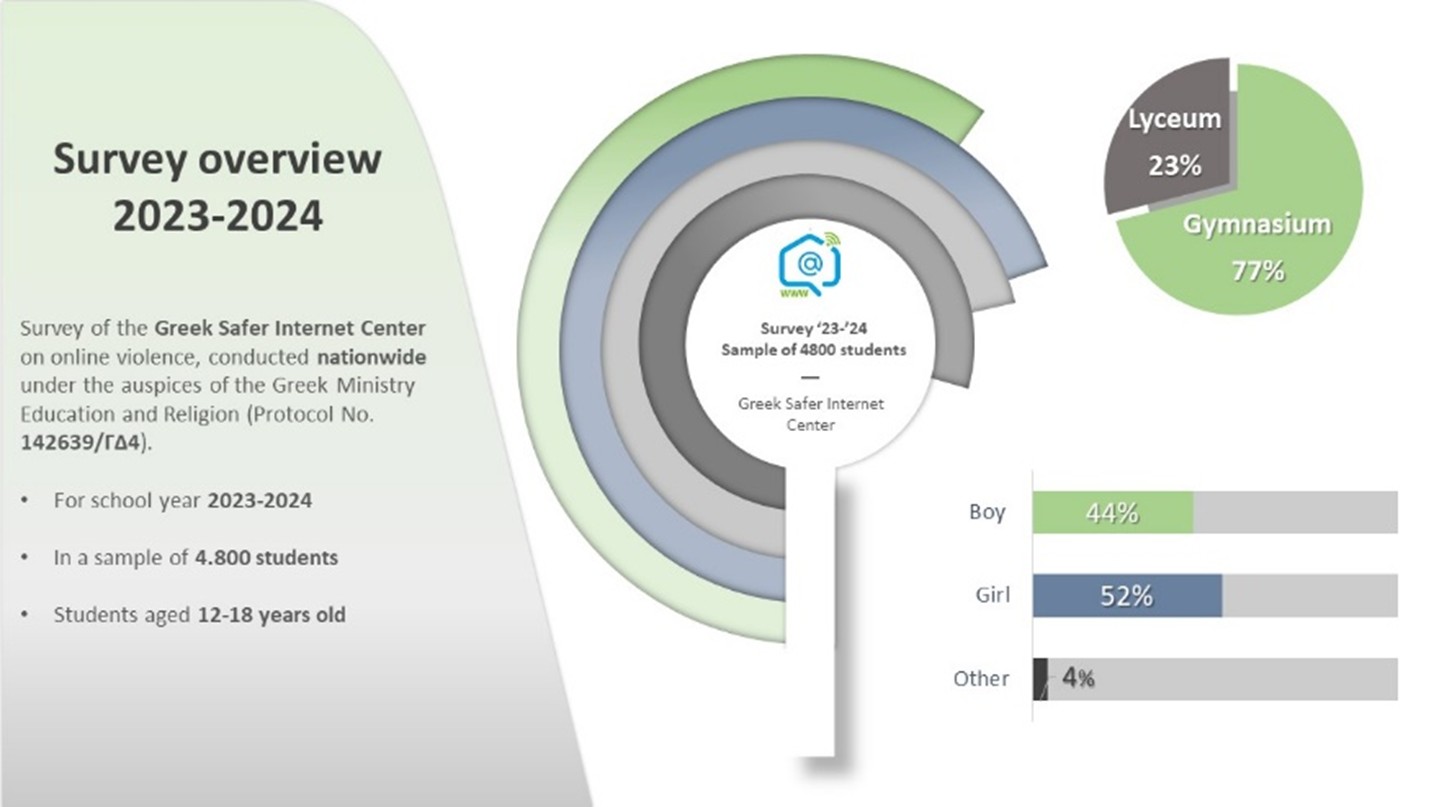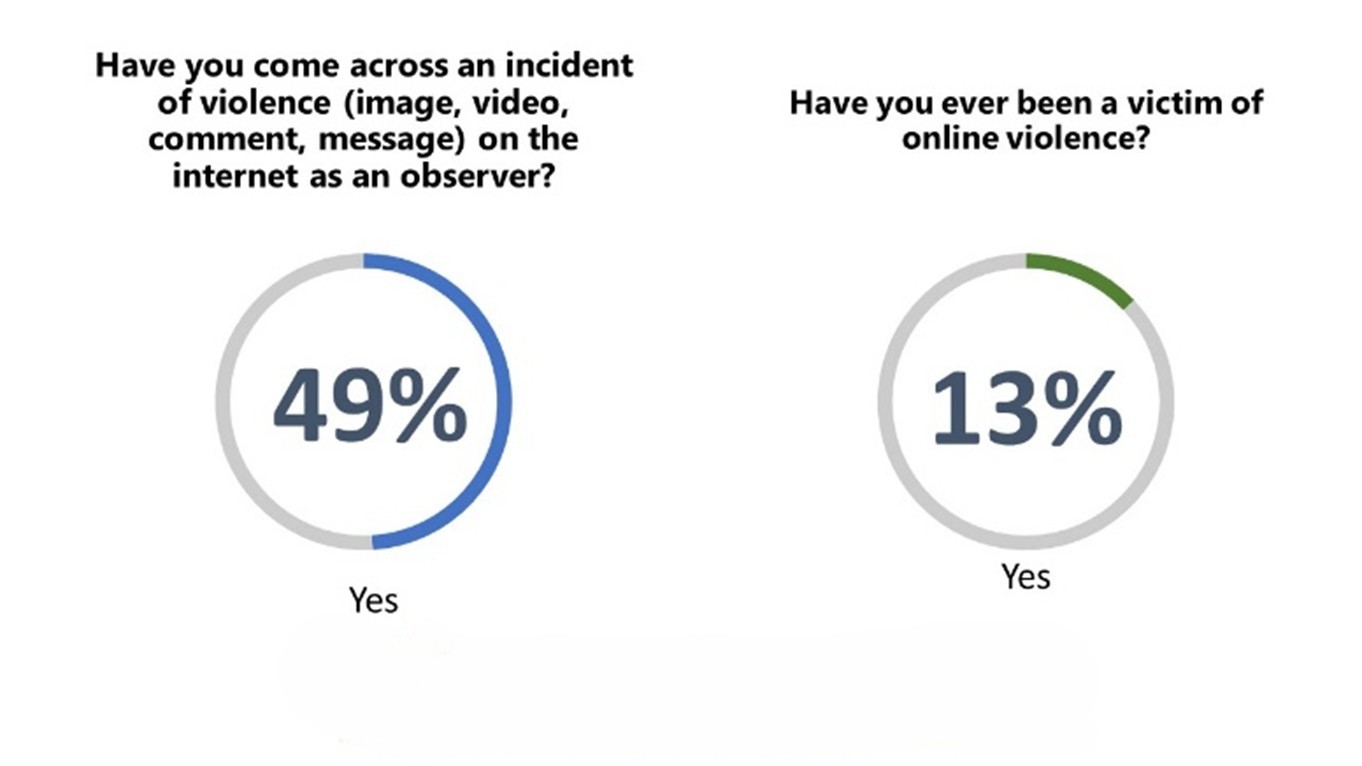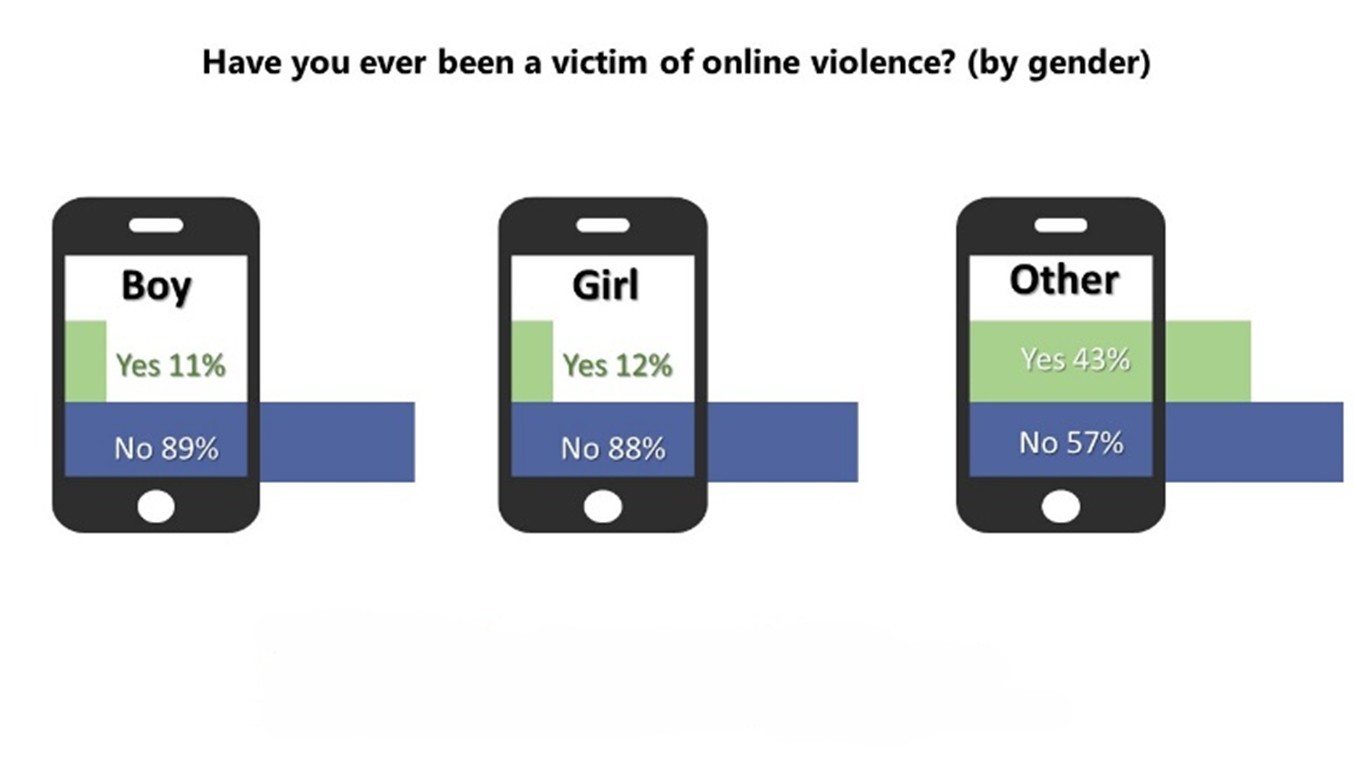The Greek Safer Internet Centre SaferInternet4Kids of FORTH conducted a survey on teenagers (12-18) between November and March 2024 on the subject of online violence. The study revealed that over half of the teenagers have been exposed to online violence either as bystanders or as victims.

About the study
The survey "Online Violence" was conducted nationwide in Greece under the approval of the Ministry of Education and Religious Affairs (No.142639/GD4) between November and March 2023-2024. A total of 4,800 students aged 12-18 participated through an online questionnaire. Out of the surveyed teenagers, 52 per cent were girls, and 48 per cent were boys.

Main findings
One of the most important findings from the survey analysis is that almost half of adolescents have been exposed to online violence as a bystander, and 13 per cent of adolescents have experienced online violence directly. An impressive 43 per cent who selected "Other" when asked about their gender in the questionnaire stated they have experienced online violence, which highlights the increased vulnerability that children and teenagers of non-conventional sexual orientation encounter online.


Other findings
Other important findings include:
- 44 per cent of teenagers have witnessed gender-based harassment or abuse incidents online, and 11 per cent have experienced gender-based harassment or abuse.
- 26 per cent of teenagers report that they have witnessed cyberbullying, and 15 per cent that they have suffered cyberbullying themselves.
- 24 per cent of teenagers reported that someone shared their personal photos/videos without their consent, and 11 per cent felt pressured or coerced to share their personal/video photos online.
- According to the analysis of the results, teenagers who chose ‘Other’ to indicate their gender are the ones who experience online violence most often. More specifically, 43 per cent of those teenagers have been victims.
- Girls seem to experience gender-based abuse or harassment more often (13 per cent) than boys (8 per cent). For the Other category, the percentage rises to 37 per cent.
- More girls than boys have witnessed gender-based abuse or harassment. Of the adolescents in the Other category, 60 per cent of them have witnessed such an incident.
- Among adolescents under the Other category, 43 per cent reported having been bullied online, 51 per cent have witnessed online bullying, 69 per cent have experienced hate speech and 68 per cent have witnessed hate speech online.
It is also worth noting that 38 per cent of teenagers do not know how to report incidents of online violence on platforms. As the survey shows, teens are not familiar with basic forms of violence such as gender-based violence or hate speech, which acts as a barrier to recognising these forms of violence when they encounter them. More specifically, 69 per cent either do not know at all or are unsure what gender-based online violence is, while 80 per cent say they do not know what online hate speech is.
This research highlights the need for further awareness among adolescents on how to react appropriately when they experience or encounter violence online.
An impressive 83 per cent of teenagers think that online violence is a big issue for minors, and 44 per cent do not feel safe using the internet. Teens seem to feel less safe on social network platforms and live streaming platforms (46 per cent), followed by online gaming platforms, chat rooms (27 per cent) and instant messaging environments (26 per cent).

The majority of teenagers (70 per cent) say they would seek help from their parents if they encountered any form of online violence. This is followed by friends (42 per cent), an adult they trust (34 per cent), the police (26 per cent), and 12 per cent say they would not ask for help at all.
Finally, 49 per cent of adolescents want clearer/easier block/report tools, 41 per cent wished for stricter penalties for incidents of online violence and abuse against minors, 37 per cent want more education at school, 33 per cent want more training for parents/guardians, and 22 per cent want young people's views to be taken into account in the design of online platforms and services.

The infographics
The main data collected is also available in the infographics below (in English). You can download them here:
Find more information about the work of the Greek Safer Internet Centre, including its awareness raising, helpline, hotline, and youth participation services – or find similar information for other Safer Internet Centres throughout Europe.
The Greek Safer Internet Centre SaferInternet4Kids of FORTH conducted a survey on teenagers (12-18) between November and March 2024 on the subject of online violence. The study revealed that over half of the teenagers have been exposed to online violence either as bystanders or as victims.

About the study
The survey "Online Violence" was conducted nationwide in Greece under the approval of the Ministry of Education and Religious Affairs (No.142639/GD4) between November and March 2023-2024. A total of 4,800 students aged 12-18 participated through an online questionnaire. Out of the surveyed teenagers, 52 per cent were girls, and 48 per cent were boys.

Main findings
One of the most important findings from the survey analysis is that almost half of adolescents have been exposed to online violence as a bystander, and 13 per cent of adolescents have experienced online violence directly. An impressive 43 per cent who selected "Other" when asked about their gender in the questionnaire stated they have experienced online violence, which highlights the increased vulnerability that children and teenagers of non-conventional sexual orientation encounter online.


Other findings
Other important findings include:
- 44 per cent of teenagers have witnessed gender-based harassment or abuse incidents online, and 11 per cent have experienced gender-based harassment or abuse.
- 26 per cent of teenagers report that they have witnessed cyberbullying, and 15 per cent that they have suffered cyberbullying themselves.
- 24 per cent of teenagers reported that someone shared their personal photos/videos without their consent, and 11 per cent felt pressured or coerced to share their personal/video photos online.
- According to the analysis of the results, teenagers who chose ‘Other’ to indicate their gender are the ones who experience online violence most often. More specifically, 43 per cent of those teenagers have been victims.
- Girls seem to experience gender-based abuse or harassment more often (13 per cent) than boys (8 per cent). For the Other category, the percentage rises to 37 per cent.
- More girls than boys have witnessed gender-based abuse or harassment. Of the adolescents in the Other category, 60 per cent of them have witnessed such an incident.
- Among adolescents under the Other category, 43 per cent reported having been bullied online, 51 per cent have witnessed online bullying, 69 per cent have experienced hate speech and 68 per cent have witnessed hate speech online.
It is also worth noting that 38 per cent of teenagers do not know how to report incidents of online violence on platforms. As the survey shows, teens are not familiar with basic forms of violence such as gender-based violence or hate speech, which acts as a barrier to recognising these forms of violence when they encounter them. More specifically, 69 per cent either do not know at all or are unsure what gender-based online violence is, while 80 per cent say they do not know what online hate speech is.
This research highlights the need for further awareness among adolescents on how to react appropriately when they experience or encounter violence online.
An impressive 83 per cent of teenagers think that online violence is a big issue for minors, and 44 per cent do not feel safe using the internet. Teens seem to feel less safe on social network platforms and live streaming platforms (46 per cent), followed by online gaming platforms, chat rooms (27 per cent) and instant messaging environments (26 per cent).

The majority of teenagers (70 per cent) say they would seek help from their parents if they encountered any form of online violence. This is followed by friends (42 per cent), an adult they trust (34 per cent), the police (26 per cent), and 12 per cent say they would not ask for help at all.
Finally, 49 per cent of adolescents want clearer/easier block/report tools, 41 per cent wished for stricter penalties for incidents of online violence and abuse against minors, 37 per cent want more education at school, 33 per cent want more training for parents/guardians, and 22 per cent want young people's views to be taken into account in the design of online platforms and services.

The infographics
The main data collected is also available in the infographics below (in English). You can download them here:
Find more information about the work of the Greek Safer Internet Centre, including its awareness raising, helpline, hotline, and youth participation services – or find similar information for other Safer Internet Centres throughout Europe.
- Safer Internet Centre (SIC) cyberviolence
Related content
- < Previous article
- Next article >












